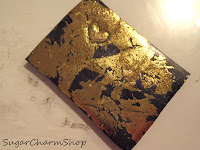Making miniature dollhouse cutting boards and knives (scale 1:12)
As I said in my other post today, I'll be posting a fair amount of tutorials in January to kickstart 2013. You're probably looking at your calender right now, aren't you? thinking; "it's the 31st of December!"... No! I hereby declare this day January the 0st... ehem, so let's get started, shall we? :)
Cutting boards are very easy to make but I have gotten questions about where I get them/how I make them in the past, so I'll be pairing it up with a short tutorial for making knives and hopefully you'll find it useful :)
-Wood (explanation below)
-Glue
-Metal sheet (explanation below)
-Saw, metal shears or small lopping shears
-Sandpaper or file
-Acrylic paint if you want :)
If you're interested in my tutorial for making miniature plates click here
1) + 2) - For the cutting boards you'll need some wood. You can use a really thin sheet of wood and cut it out in the size you want, or you can use things like wodden stirring sticks for paint, wide popsicle sticks (at least that's what I call them.. got them from a local craft store) - matchsticks can make some cool looking cutting boards as well. Saw or cut out the boards in the size/shape you want and smooth the edges using some sandpaper or a file.
3) - If you want to add a little extra detail you can use your blade or knife to cut some lines in the surface of the wood. This will make the cutting board look like it's actually been used.
4) - To make the lines stand out, make the cutting board look more worn and just to add a prettier color, I thinned out some dark brown acrylic paint with water and applied it to the wood. As you can see I made a areas darker than the rest - not for any particular reason, I just like that look.
You now have your miniature dollhouse cuttingboard.
5) - For the knife you'll need some sheets of metal. You can find this at hardware stores OR you can use what you probably already have - cans. Try to use cans where the metal isn't too soft (to avoid curly and bent looking knives).
Don't worry if your can has a golden color on one side and silver on the other - if you're going to glue this down to a plate, cutting board or miniature scene this won't matter :)
6) - for the handle you can use polymer clay or wood - I chose wood. For this knife I used a matchstick (toothpicks make great handles as well). You can also use larger wooden sticks to create handles with more detail and curves. I used a file to make the matchstick thinner/more flat, smoother and rounded at one end, then used my clay blade to make a small cut at the other end, where the blade of the knife will be attached.
7) - Cut out a blade for your knife. If you notice, the cutting side of my miniature knife has a 'wavy' look, almost like a bread cutting knife - this is the pattern that my metal cutting shears leave, great for miniature knives! I cut the rest of the knife with a regular pair of scissors (not recommended if you want to be good to your scissors) to get a straight edge.
Glue the handle in place, let dry and paint it if you want. You can add more details, this is just a quick basic knife that'll look cool on your small cooking scenes.
















































